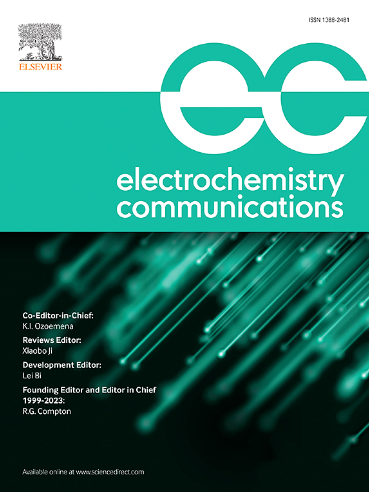Superior electrochemical performance of CuS/FeSe2 for advanced asymmetric supercapacitor applications
IF 4.7
3区 工程技术
Q2 ELECTROCHEMISTRY
引用次数: 0
Abstract
Supercapacitor devices face significant challenges, including limited energy density, high self-discharge rates, and poor performance over extended cycling. The present study developed a high-performance asymmetric supercapacitor using novel CuS/FeSe2 nanocomposites fabricated using a scalable wet chemical method. The CuS/FeSe2 nanocomposites exhibited exceptional electrochemical performance, including significant capacitance and redox behavior improvements. Integrating two pseudocapacitive materials in a three-electrode configuration exhibited a synergistic effect, substantially reducing resistance and surpassing individual CuS and FeSe2 electrodes. The CuS/FeSe₂ nanocomposite demonstrated the highest Cs among the electrodes, achieving 821.3 Fg−1 at 1 Ag−1, surpassing the performance of the individual CuS (248.3 Fg−1) and FeSe₂ (508 Fg−1) electrodes along with 80.4 % retention. The asymmetric supercapacitor (CuS/FeSe2||AC) demonstrated excellent cycling stability, retaining 90.1 % of its initial capacity after 7000 continuous charge/discharge cycles at the highest current rate. Operating at a voltage cutoff of 1.6 V in an aqueous electrolyte, it achieved a high energy density of 51.1 Wh/kg, delivering power at 2426.3 W/kg, and exhibiting a specific capacitance of 143.6 F/g. The CuS/FeSe2 nanocomposite shows significant potential for high-performance energy storage devices, particularly for developing next-generation asymmetric supercapacitors.
cu /FeSe2在先进非对称超级电容器中的优异电化学性能
超级电容器器件面临着巨大的挑战,包括有限的能量密度,高自放电率,以及长时间循环性能差。本研究利用新型cu /FeSe2纳米复合材料,采用可扩展湿化学方法制备了高性能非对称超级电容器。cu /FeSe2纳米复合材料表现出优异的电化学性能,包括显著的电容和氧化还原性能改善。在三电极结构中集成两种假电容材料表现出协同效应,大大降低了电阻,超越了单独的cu和FeSe2电极。cu /FeSe₂纳米复合材料在1 Ag−1时的Cs值最高,达到821.3 Fg−1,超过了单独的cu (248.3 Fg−1)和FeSe₂(508 Fg−1)电极的性能,并且保留率为80.4%。非对称超级电容器(cu /FeSe2||AC)表现出优异的循环稳定性,在最高电流率下连续充放电7000次后保持了90.1%的初始容量。在1.6 V的截止电压下,在水溶液中实现了51.1 Wh/kg的高能量密度,输出功率为2426.3 W/kg,比电容为143.6 F/g。cu /FeSe2纳米复合材料在高性能储能器件方面显示出巨大的潜力,特别是在开发下一代非对称超级电容器方面。
本文章由计算机程序翻译,如有差异,请以英文原文为准。
求助全文
约1分钟内获得全文
求助全文
来源期刊

Electrochemistry Communications
工程技术-电化学
CiteScore
8.50
自引率
3.70%
发文量
160
审稿时长
1.2 months
期刊介绍:
Electrochemistry Communications is an open access journal providing fast dissemination of short communications, full communications and mini reviews covering the whole field of electrochemistry which merit urgent publication. Short communications are limited to a maximum of 20,000 characters (including spaces) while full communications and mini reviews are limited to 25,000 characters (including spaces). Supplementary information is permitted for full communications and mini reviews but not for short communications. We aim to be the fastest journal in electrochemistry for these types of papers.
 求助内容:
求助内容: 应助结果提醒方式:
应助结果提醒方式:


